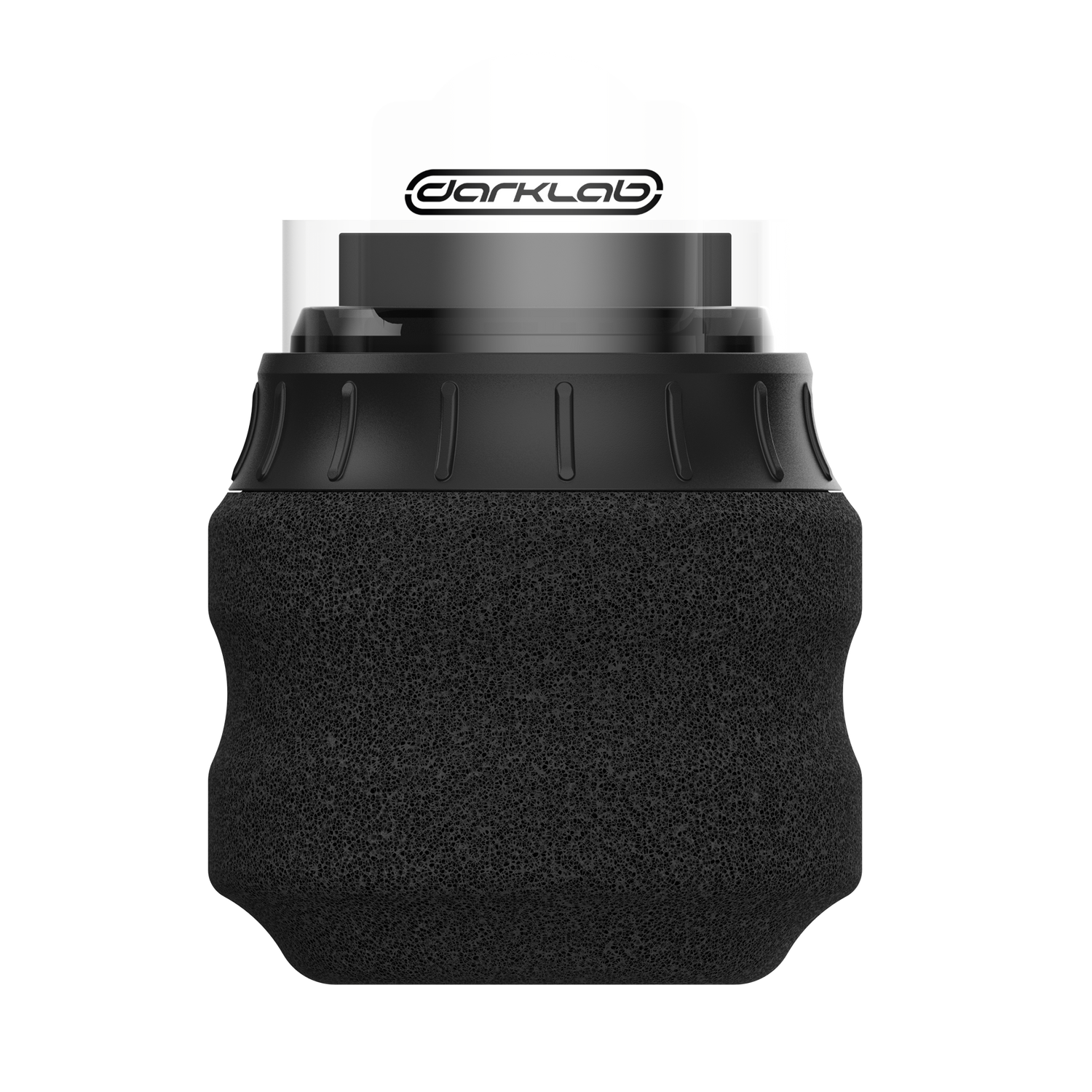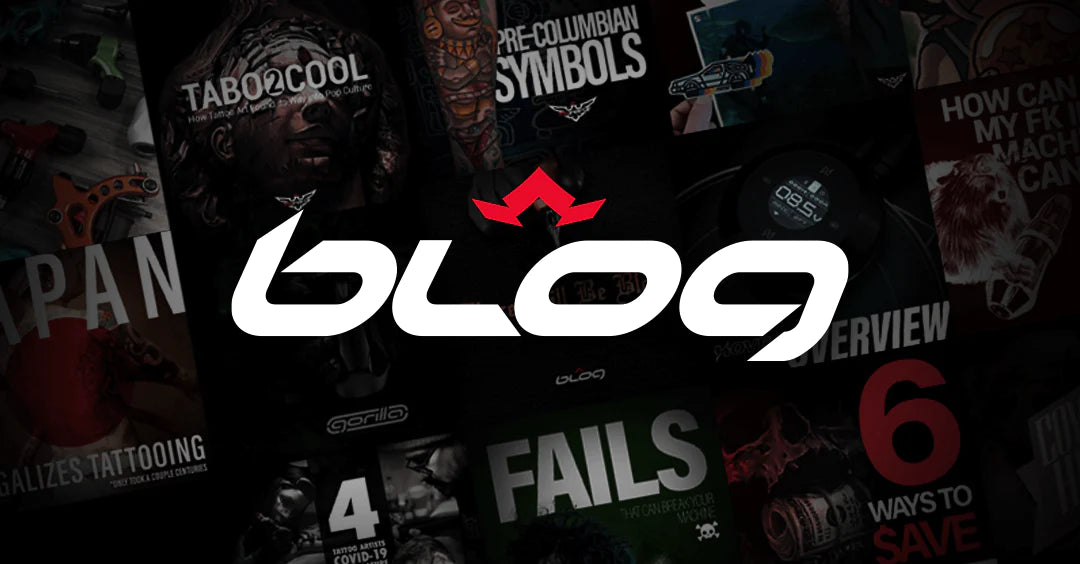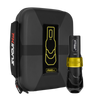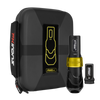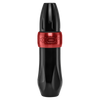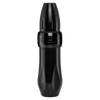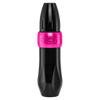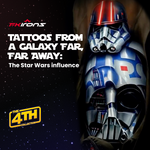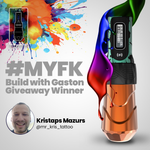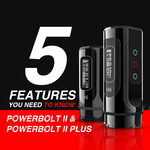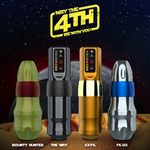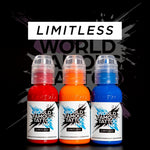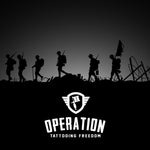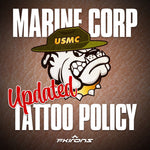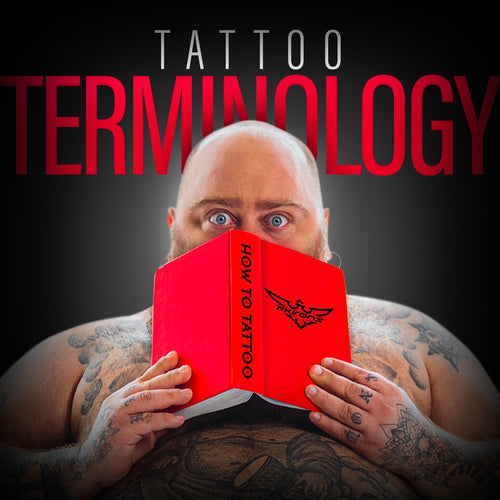
This tattoo glossary is meant for those interested in slightly more technical explanations, although we'll highlight how every advanced term matters in your tattooing.
Instead of an alphabetical listing, we have arranged the terms by topic.
Index
1. Blowout
2. Sterilized water
3. Stroke Cam
4. Give
5. E-Give
6. Traditional Needle
7. Needle Cartridge
8. Needle Cartridge with a Membrane
9. Needle Diameter / Gauge
10. Needle Configuration or Grouping
11. Common Needle Configurations and Abbreviations
11.1 Round Liner
11.2 Flat
11.3 Magnum / "Mag"
11.4 Soft Edge Magnum or Curved Magnum Needles
11.5 Stacked Magnums
11.6 Bugpin
12. Tattoo Needle Abbreviations
13. Needle Taper
When Tattoos Go Wrong
Blowout: After the tattoo heals, the ink spreads, leaving a halo effect.
This is usually a result of the tattoo artist implanting too deeply in the skin combined with body's natural protective process, which tries to get rid of the "invader," or ink.
Sterilized water: Water that has been processed in a way that it is free of microbes, such as bacteria, fungi, spores.
Tap water is not a good choice for diluting your pigments or cleaning. The use of non-sterile water has resulted in terrible infections in customers' skin.
San Diego county warns that legionella, pseudomonas and mycobacteria can result in "severe illness and when left untreated, they may be fatal." This just iterates your bloodborne pathogens certification and the importance of sterilization practices.
Tattoo Machine Parts and Features
Stroke Cam: In motors, a cam is a flat, rotating plate with a small bearing riding on top. The cam's purpose is to change the type of motion from rotational to linear. To achieve this, the cam uses intermediary machine pieces. When a tattoo machine is activated by electricity, the cam spins and with the aide of those intermediary pieces, pushes the needle back and forth.
The size and weight of the cam itself is what determines how much centrifugal force the cam exerts on the other moving pieces. (If you're trying to remember what centrifugal force is, just think back to your childhood, when you would lock arms with your BFF and spin, facing each other, holding on tight to each others' arms until you felt like you were both going to go flying. The bigger the kids, the bigger the force.)
HOW THIS IMPACTS TATTOOING
The bigger the cam >> the more force is exerted >> the more the needle will protrude >> the longer your needle stroke will be!
Note that the difference in cam sizes is nearly imperceptible to the naked eye, but even that tiny difference will give you a very different "stroke length."
In FK Irons' Xion machines our cams look slightly different, and we even have one less gear than most rotary machines. FK Irons' patented straight lever system immensely reduces vibration and wear and tear in comparison to traditional rotary mechanics.
Our newest machine, the wireless Flux has even fewer intermediary pieces between the cam and the needle, making it more powerful.
Give: How hard or soft the machine/needle hits, or another way to think of it is how responsive it is upon impact on the skin.
When the needle hits the skin, how much will it resist when it hits a thicker or harder area in comparison to when it encounters softer, easier-to-penetrate skin?
Will it insist and hit the skin hard (i.e. "low give") or will your needle and machine be more receptive to how much the skin will permit it (i.e. "high give")?
However, FK Irons is always changing the game and we have found a way to hack direct drive machines and get "give" out of them with E-Give!
E-Give: The FK Irons trademarked name for the manipulation of the give -even on direct drive machines!- through electronic means.
The Darklab mobile app will offer various advantages, but the most revolutionary reveal is E-Give, where you can easily adjust the torque and allow the skin to be the give.
Tattoo Needles

Traditional Needle: The one long needle that ends in a loop and usually includes the use of a rubber band. These are the typical needles used before pen-style machines and tattooing cartridges came out.

Needle Cartridge: Generally, a cartridge is a container that is meant to be inserted into some sort of machine, such as a printer or a gun. With regard to tattoo machines, the "case," or "cartridge," is filled with needles.

Needle Cartridge with a Membrane: Generally, a membrane is a dividing barrier that is meant to prevent or regulate the passage of liquids, cells, etc. from one area to another. In the case of cartridge needles, some have a plastic membrane barrier and others don't.
Cartridges with membranes are the tattoo industry standard, however there are cheap, chintzy cartridges on the market without a membrane. Tattoo artists and the industry steer clear from these substandard versions because of the health dangers that cross-contamination pose.
HOW THIS IMPACTS TATTOOING
For tattoo machines whose grips are not separate from the cartridge - i.e. most "pen" tattoo machines - a membrane is absolutely critical to prevent back flow of ink and bodily fluids into the machine.
Any liquids entering your motor will most assuredly ruin it. Imortantly, the back flow of blood or any other fluids can contaminate your machine and endanger your clients.
Note: the use of non-membrane cartridge needles in FK Irons pen-style machines voids the warranty!
Needle Diameter / Gauge: the width (diameter) of each, individual needle. In the tattoo world, some needle manufacturers will refer to a number instead of the diameter per se. For instance:
Needle Configuration or Grouping: how close the needles are together and what shape they are placed in.
Usually it's not just one needle inside of a cartridge, but rather multiple. The more needles you have, the more you can pack in the color.
A tight needle grouping in a circle with many needles will give you a very different result from a grouping with just three needles in a straight line, for instance.

Common Needle Configurations and Abbreviations
Round Liner: One, single needle or more, in a tight grouping intended for line work. The single is most often used for tiny tattoos, microrealism and cosmetic tattooing on delicate facial skin and lips.
Flat: A grouping of needles placed side-by-side, whose tips are all level with each other. (See "standard" in the Needle Configurations diagram below).
Magnum / "Mag": More than one needle arranged side-by-side, but this differs from the Flat in that "Mag" is just the name for the general category of needles that are arranged side-by-side.
If you want to differentiate the Flat from the curved, then you would specify soft edge/curved mags, then you would call them Curved or Soft Edge. Read below.
Soft Edge Magnum or Curved Magnum Needles: A grouping of needles placed side by side, where the ones in the center protrude slightly more than the needles on the edges, forming a "curved" or "soft" edge.
Stacked Magnums: Two rows of needles arranged side-by-side.
Bugpin: Magnums made with the thinner needles (usually the .25mm) and tightly packed together.
Tattoo Needle Abbreviations
RL = Round Liner (in a circle)
RLT or RLXT = Round Liner Tight or Extra Tight (in a tighter circle)
RS = Round Shader (in a looser circle than the RL)
F = Flat (More than one needle arranged side-by-side, specifically forming a flat edge at the tips)
M = Mags (More than one needle arranged side-by-side. Can be curved or straight edged, but unless specified straight is usually the standard)
M1C = Curved Magnum (one layer of needles)
MC = Curved Magnum (can be one layer of needles or multiple)
M2 = Stacked Magnum (two layers of needles)
MS = Magnum Shader (two layers of tightly packed needles)
BP = Bugpin

Needle Taper: The distance it takes for the needle to start getting narrower until it ends at it's point. The longer the distance, the thinner that needle taper is.
Tapers are usually classified simply as short, medium and long taper.
A long taper will look very thin, as it gets narrow very slowly and the tip will look very sharp.
In comparison, a short taper will look kind of bull-nosed, and even if the tip is actually pointy, it will look slightly duller simply because it is shorter.
The diagram above highlights the advantages of each needle taper.
This glossary of tattoo terms will get longer as we hear more questions from you on our YouTube, Facebook or Instagram accounts. Follow them and ask away; we're up for the challenge of adding the tougher terminology here.
